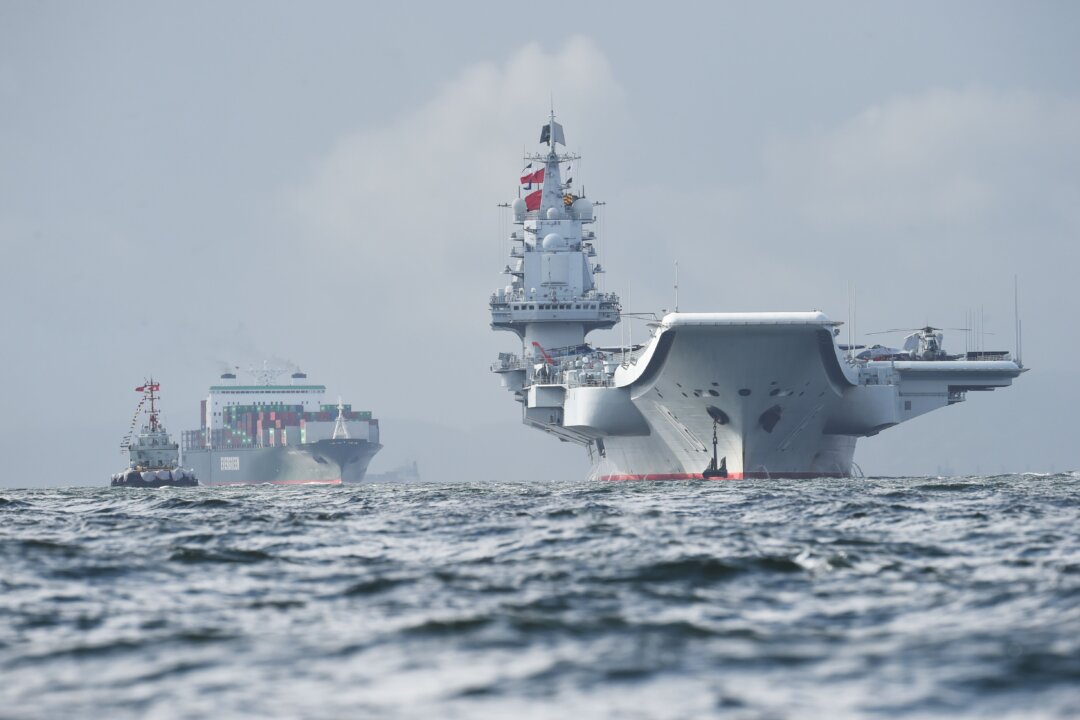The exercises could rattle China’s neighbors that have longstanding territorial disputes with Beijing over its expansionist activities in the waters.
China has conducted a series of unprecedented military exercises using both of its aircraft carriers and a fleet of support vessels in the South China Sea.
Chinese state media unveiled video of the Liaoning and Shandong carrier groups conducting their first dual formation exercise on Oct. 31.
Video of the exercises showed the two aircraft carriers, China’s first, sailing through an unspecified area of the South China Sea with around a dozen smaller support ships in tow and a similar number of fighter aircraft flying in formation above.
Fighter aircraft can also be seen taking off and landing on the deck of one of the ships using a similar type of launch technology employed by Russian and Indian aircraft carriers.
The exercises were intended “to hone and improve the combat capability of the aircraft carrier formation system,” according to a social media account run by the People’s Liberation Army (PLA), which is the military wing of China’s ruling communist party.
The exercises are the first of their kind and mark a major milestone in the development of China’s maritime capabilities, mirroring similar exercises conducted by two U.S. carriers in the Indo-Pacific in 2021.
Exercises with two aircraft carriers and their associated support vessels require a high level of operational flexibility and showcase the ability to deploy and sustain extensive air and sea power, providing a powerful deterrent to potential adversaries.
The PLA navy operates the Liaoning and the Shandong as its two active aircraft carriers. China’s third carrier, the Fujian, was unveiled in June 2022. It is still undertaking sea trials and is not yet operational.
The Liaoning was originally laid down as a Soviet ship in the mid-80s, whereas the Shandong was built domestically beginning in 2013.
The Fujian, meanwhile, began its sea trial in May of this year and is China’s first domestically designed carrier. It also boasts more advanced electromagnetic catapult technologies, similar to those of newer U.S. Navy carriers.
The exercises are also likely to rattle China’s neighbors, many of whom have longstanding territorial disputes with China owing to Beijing’s expansionist activities throughout the South China Sea.
Chinese vessels have repeatedly harassed and even collided with those from the Philippines, and Vietnam in recent months, and clashes have occurred between Chinese and Indonesian vessels. Officials from Vietnam and the Philippines have also reported that their crews have been sprayed with high-pressure hoses and beaten with metal pipes by Chinese law enforcement operating illegally out of Chinese waters.
U.S. Secretary of State Antony Blinken addressed regional leaders about the violence in early October, condemning China’s “increasingly dangerous and unlawful actions” in the South and East China seas.
The ability to deploy both carriers in close coordination will also be paramount to China’s ability to project power internationally as Beijing continues its attempts to expand its overseas military presence.
To that end, the Chinese Communist Party (CCP) has established an overseas military base in Djibouti and is also funding the creation of a deep water port in Cambodia, which it is expected the PLA will retain access to.
The CCP also maintains spy bases abroad, including in Cuba, and it is possible the PLA could send naval assets to make ports of call in the United States’ backyard in the coming years.
Thursday’s exercises may additionally serve the purpose of signaling China’s readiness for the conquest of Taiwan, a task that CCP leader Xi Jinping has ordered the PLA be prepared to undertake by 2027. The U.S. Navy, meanwhile, has also received guidance to prepare itself for a war with China by 2027.
It is currently unclear what, if any, effect the exercises will have on U.S. posture and actions in the Indo-Pacific region.
The Epoch Times contacted the U.S. Department of Defense for comment but didn’t receive a reply by publication time.
Reuters contributed to this report.

